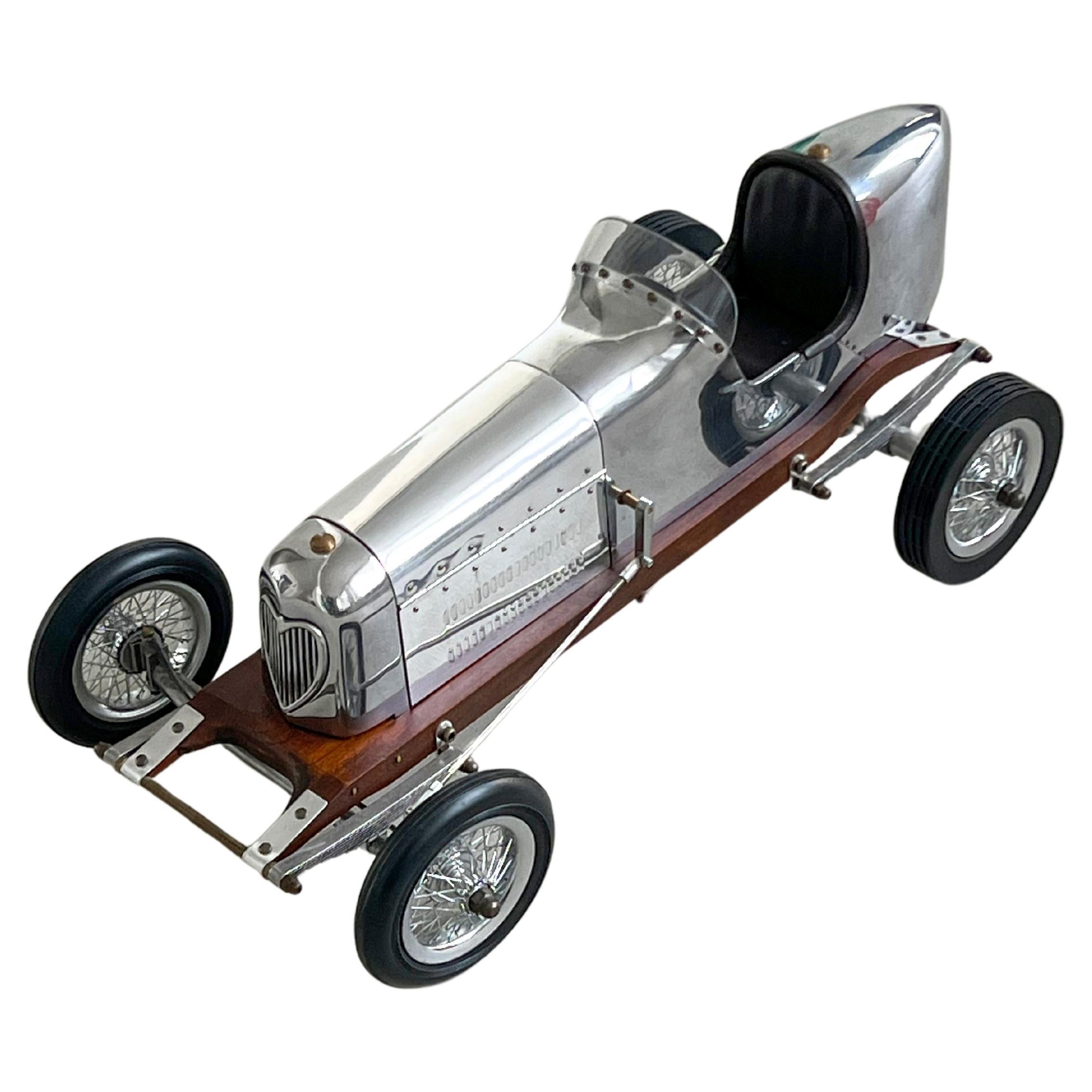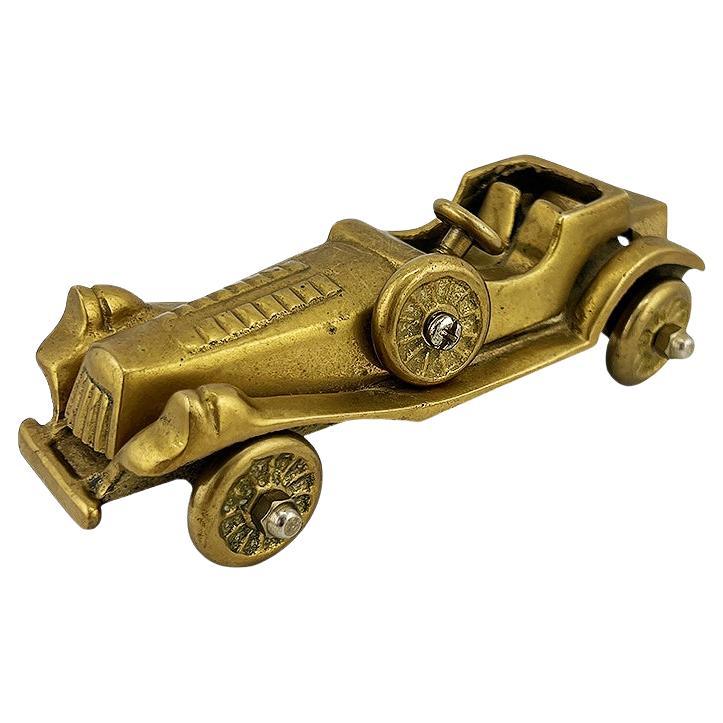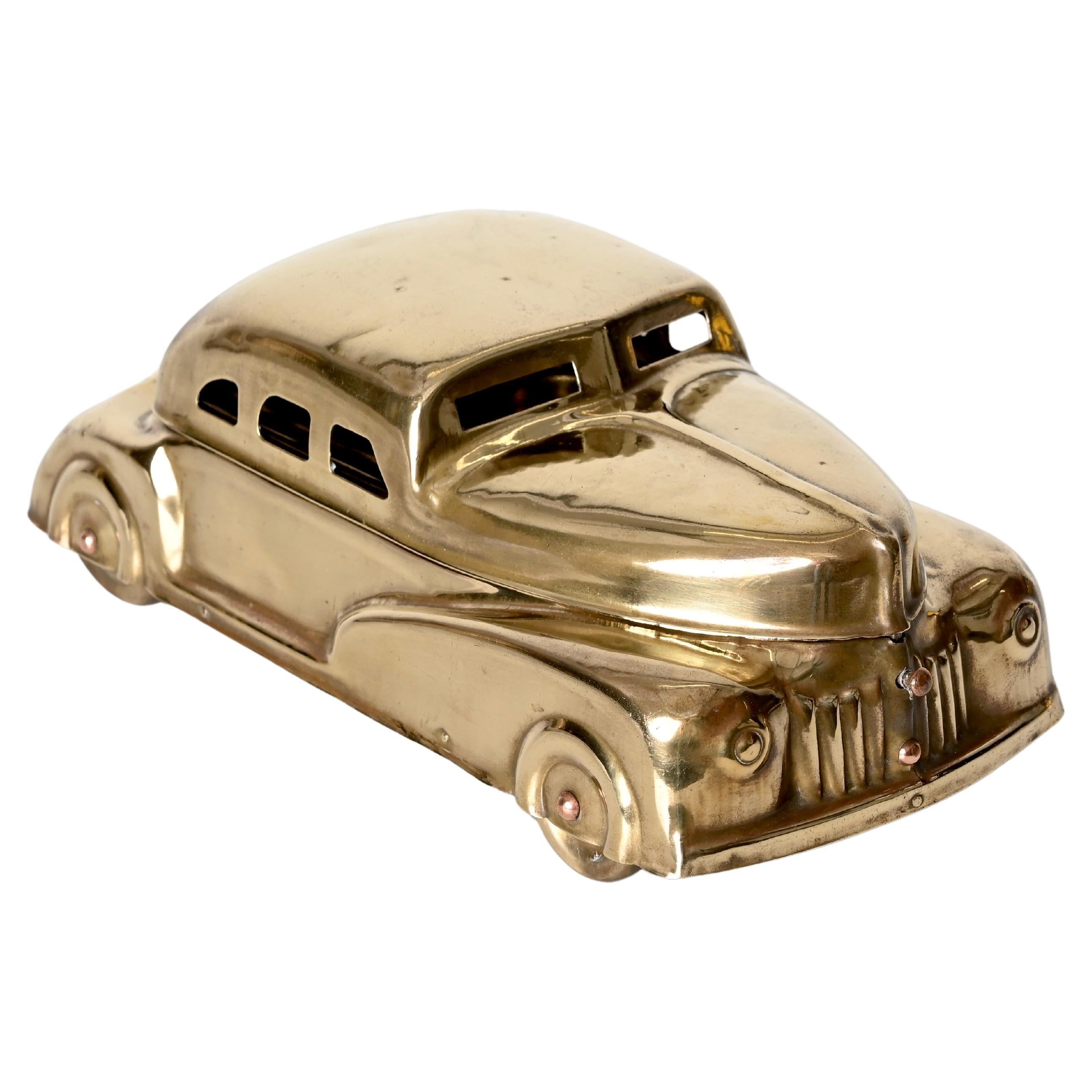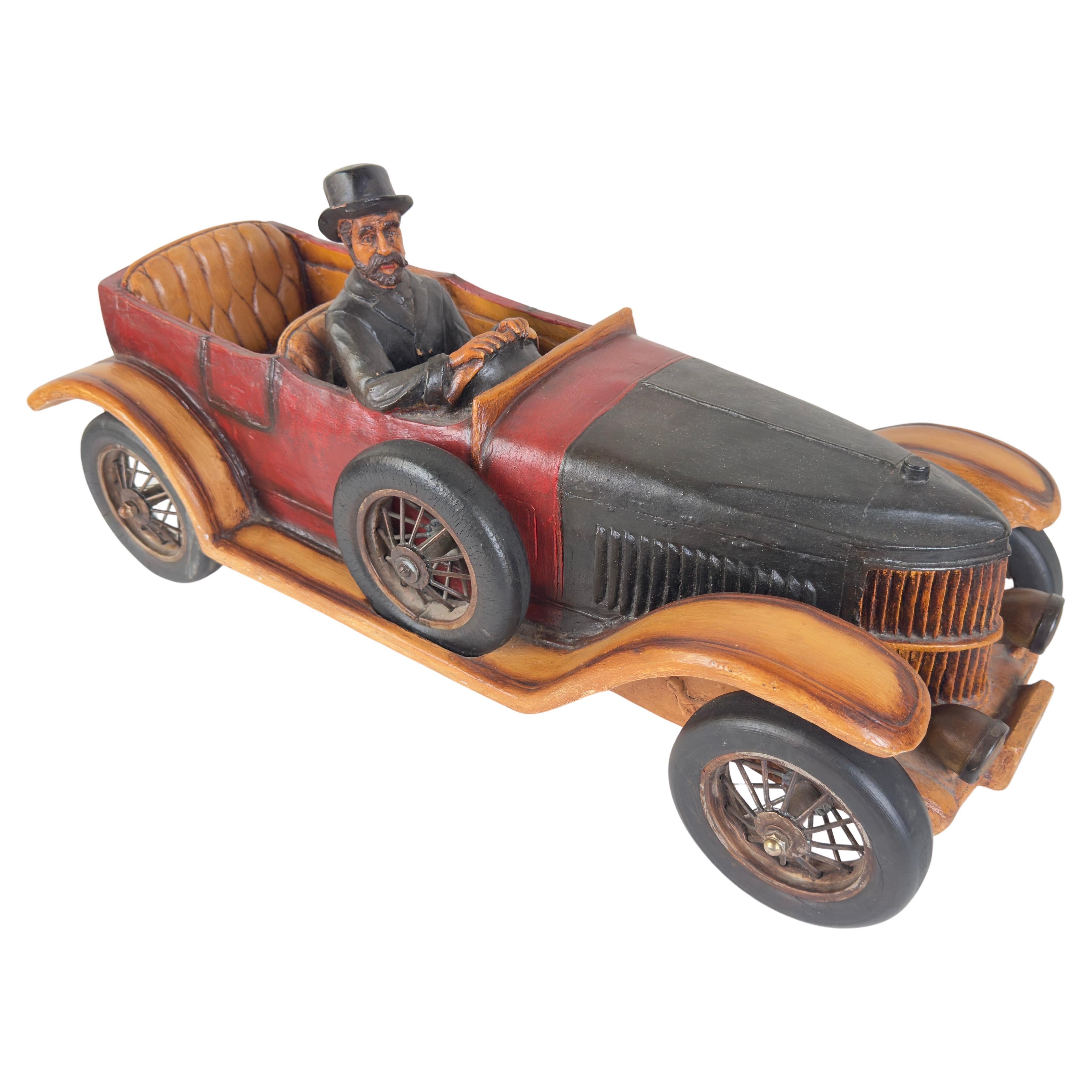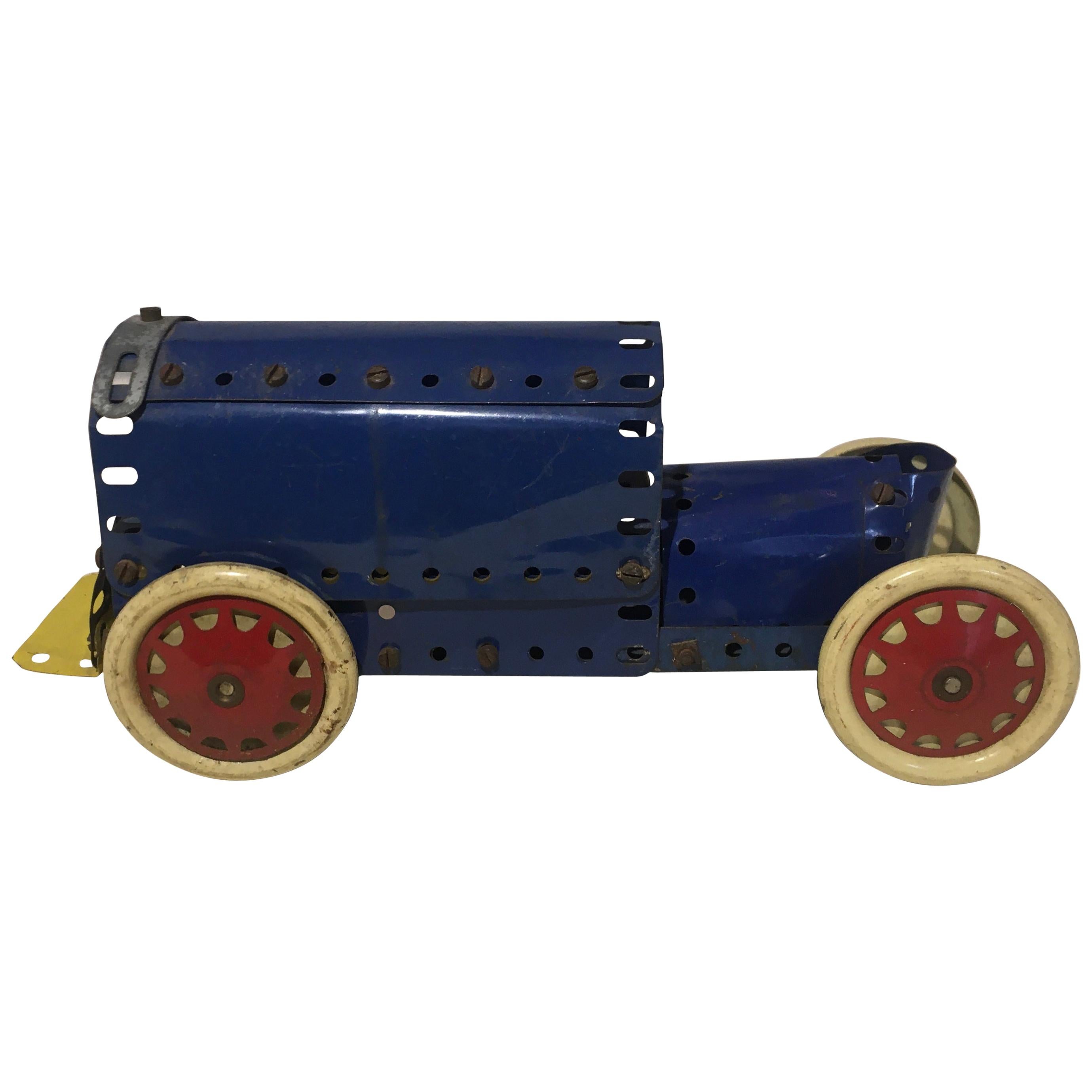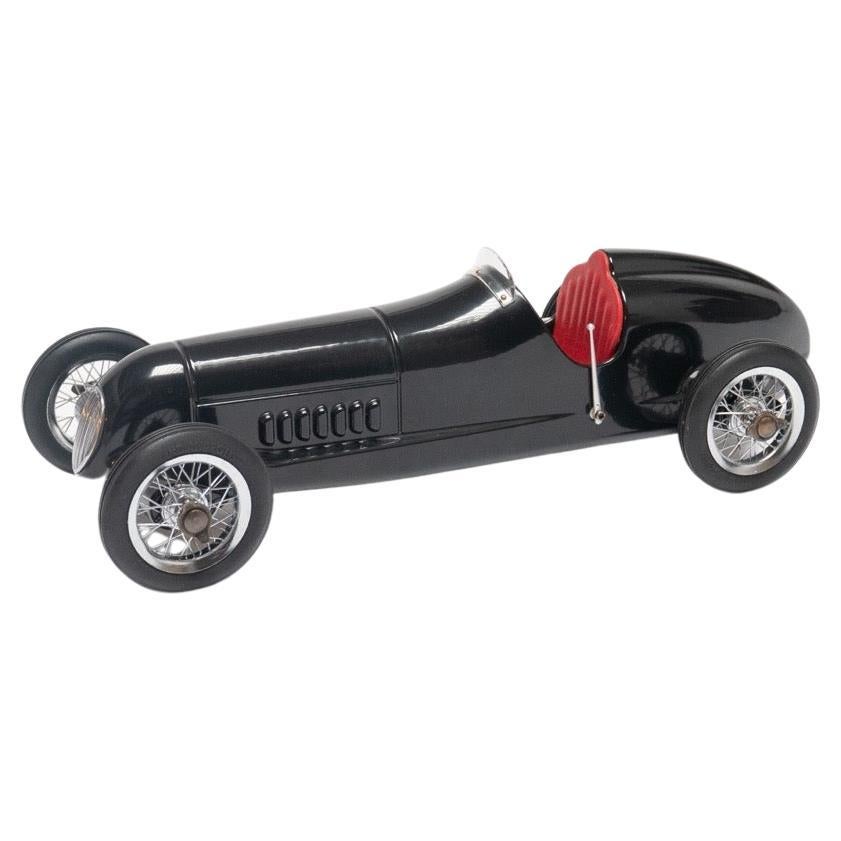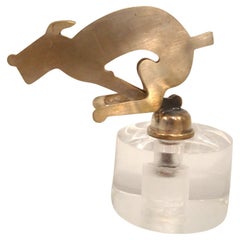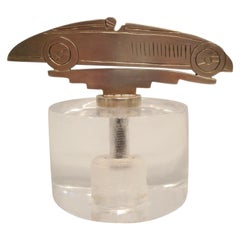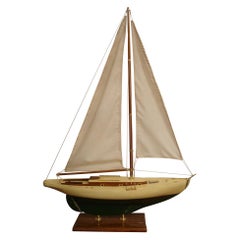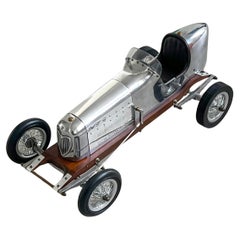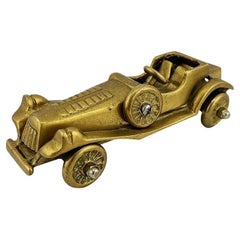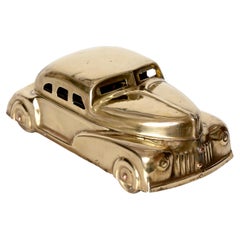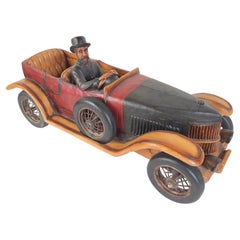Items Similar to Folk Art Early Racing Speedway, Indianapolis Type, Brass and Wood, Automobilia
Want more images or videos?
Request additional images or videos from the seller
1 of 9
Folk Art Early Racing Speedway, Indianapolis Type, Brass and Wood, Automobilia
$1,499
£1,138.23
€1,301.65
CA$2,094.32
A$2,329.34
CHF 1,216.31
MX$28,345.61
NOK 15,534.13
SEK 14,568.27
DKK 9,714.69
Shipping
Retrieving quote...The 1stDibs Promise:
Authenticity Guarantee,
Money-Back Guarantee,
24-Hour Cancellation
About the Item
Fantastic vintage racing car, the Indianapolis type. Very nice done. Handmade. Perfect for any Automobilia, or Car Mascot - Hood Ornament collector. Very good conditions. Just got a light repolish. And a little painting. The wheels have movement.
We have specialized in the sale of Art Deco and Art Nouveau and Vintage styles since 1995. If you have any questions we are at your disposal. Pushing the button that reads 'View All From Seller'. And you can see more objects to the style for sale. Why are there so many antiques in Argentina?
In the 1880 – 1940 there was a grate wave of immigration encouraged by the periods of war that were taking place. 1st World War took place between 1914 and 1918 2nd World War took place between 1939 and 1945 The immigrants options were New York or Buenos Aires. Tickets were cheap and in Buenos Aires they were welcomed with open arms, as it was a country where everything was still to be done. Argentina was the country of new opportunities, labour was needed and religious freedom was assured, in many cases the of the family travel first until they were settled and then the rest of the family members join them. In the immigrant museum “Ellis Island Immigrant Building” in New York you can se the promotional posters of the boats that would take them to a new life. Between the years 1895 and 1896, Argentina had the highest DGP (gross domestic product) per capita in the world according to the Maddison Historical Statistics index, this situation arose due to the large amount of food being exported to European countries, which were at war. The Argentinean ships left the port of Buenos Aires with food, but they returned with furniture, clothes and construction elements, (it´s common to see this the old buildings of the historic neighbourhood of San Telmo, the beams with the inscription “Made in England)”, as well as many markets that were built in Buenos Aires, such us the San Telmo Market, whose structure was brought by ship and afterwards assembled in 900 Defensa Street. With the great influence of European immigrants living in the country, the children of the upper classes travelled to study in France, resulting in the inauguration of “La Maison Argentinienne”, on 27th of June 1928, in the international city of Paris, which hosted many Argentinians that were studying in Frace. It´s the fourth house to be built after France, Canada and Belgium, being the first Spanish-speaking one. Still in place today (17 Bd Jourdan, 75014, Paris, France). Many of the children of these wealthy families who attended international art exhibitions, museums and art courses abroad, took a keen interest in the European style. This is why Buenos Aires was at the time referred as “The Paris of South America”. Between the years 1890 and 1920 more than a hundred Palaces were built on Alvear Avenue the most exclusive avenue in Buenos Aires. Today some of these palaces have been transformed into museums, hotels and embassies. In the year 1936, the Kavanagh building was inaugurated, it was the tallest reinforced concrete building in South America. During 1994 the American Society of Civil Engineers distinguished it as an “international engineering milestone”, and it´s now considered a World Heritage of Modern Architecture. At the time was common to hire foreign architects such as Le Corbusier, who visited Buenos Aires/Argentina in 1929 and in 1948 he drew up the blueprints for a house built in La Plata City (which was declared a World Heritage Site). In 1947, the Hungarian architect Marcelo Breuer designed “Parador Ariston” in the seaside city of Mar del Plata. After an Argentinean student at Harvard University convinced him to come to Argentina. He worked on an urban development project in the Casa Amarilla, area of La Boca. The Ukrainian architect, Vladimiro Acosta, arrives in Argentina in 1928 and worked as an architect until que moved to Brazil. Antonio Bonet, a Spanish architect who worked with Le Corbusier in Paris, arrives in Argentina in 1937, where he carried out several architectural works and in 1938 designs the well-known BFK chair. Andres Kálnay, of Hungarian origin, made around 120 architectural masterpieces, among which the former Munich brewery stands out, he even made the furniture’s design. The German architect, Walter Gropius, director of the Bauhaus, lived in Argentina, where he wrote articles for “Sur” magazine and founded in Buenos Aires, an architectural firm with Franz Möller, who was also an architect, where he built two houses. At the same time several famous designers decided to immigrate to Argentina, among them we can find the well-known French designer, Jean-Michel Frank, who arrived in the country in 1940 and also worked for the Rockefeller family. Special pieces were made, which were sold exclusively in the country, such as the well-known German company “WMF”, who sold their products by catalogue, which were chosen by the ladies of high society in the list of wedding gifts, as well as the pieces designed by Christofle. The Swiss sculptor Alberto Giacometti, made special pieces for Argentinean mansions. In 1904 the first Jansen branch outside Paris was established in Buenos Aires, as the Argentinean clientele demanded a large amount of furniture, from the end of the 19th century to the mid-20th century. In 1970, the brand Rigolleau Argentina made pieces authorised by Lalique. The brands Maple and Thompson also set up shop in the country. The French plastic artist, Marcel Duchamp moved to Argentina in 1918-1919. Glass signed Gallé, Charder, Leverre, Schneider, Muller and other French firms. They were bought in flower shops and were given to ladies with beautiful floral arrangements. Some furniture manufacturers travelled to international fairs and bough the patterns to produce the furniture in Argentina, such as the furniture firm Englander and Bonta, who bought the patterns in Italy. It is worth mentioning that in Argentina we have the largest community of Italians outside of Italy, as it is estimated that 70 percent of the inhabitants have at least one Italian descendant, followed by Spanish immigrants. The most Important furniture stores in Argentina: Comte is founded in 1934 (under the direct management of Jean Michel Frank in 1940). Nordiska (Swedish company established in 1934). Churba in 1960, a company that brought foreign designers to present their furniture in the country: Denmark: (Arne Jacobsen, Finn Juhl, Bender Madsen, Ejner Larsen, Poul Kjaerholm, Hans Wegner) Sweden: (Hans Agne Jakobsson, Gustavsberg) United States: (Herman Miller) Finland: (Lisa Johansson, Folke Arstrom, Tapio Wirkkala, Alvar Aalto, Timo Sarpaneva) Swedish Factory: (Orrefors) Italy: (Littala, Vico Magistretti, Emma Gismondi, Gae Aulenti, Angelo Mangiarotti, Elio Martinelli, Gianna Celada, Angelo Mangiarotti, Mario Bellini, Carlo Scarpa) Finland: (Olivia Toikka) Plata Lappas (Lappas Silver): a goldsmith shop founded in 1887 in Argentina by Alcibiades Lappas of Greek origin. In 2019, in Argentina took place “the Art Deco world congress” . Argentina currently has more than 100 Art Deco buildings and another 90 Art Nouveau buildings throughout the city of Buenos Aires. Argentina is a country that has not been involved in many wars, which is why it has been a refuge for works of art and antiques from different periods of time, unlike European countries. That is way many collectors, museums and antique dealers from all over the world visit it, you should not miss the opportunity to visit this great country.
- Dimensions:Height: 2.37 in (6 cm)Width: 7.88 in (20 cm)Depth: 3.55 in (9 cm)
- Style:Art Deco (Of the Period)
- Materials and Techniques:
- Place of Origin:
- Period:
- Date of Manufacture:1920s
- Condition:Refinished. Repaired. Wear consistent with age and use.
- Seller Location:Buenos Aires, AR
- Reference Number:1stDibs: LU2027310537873
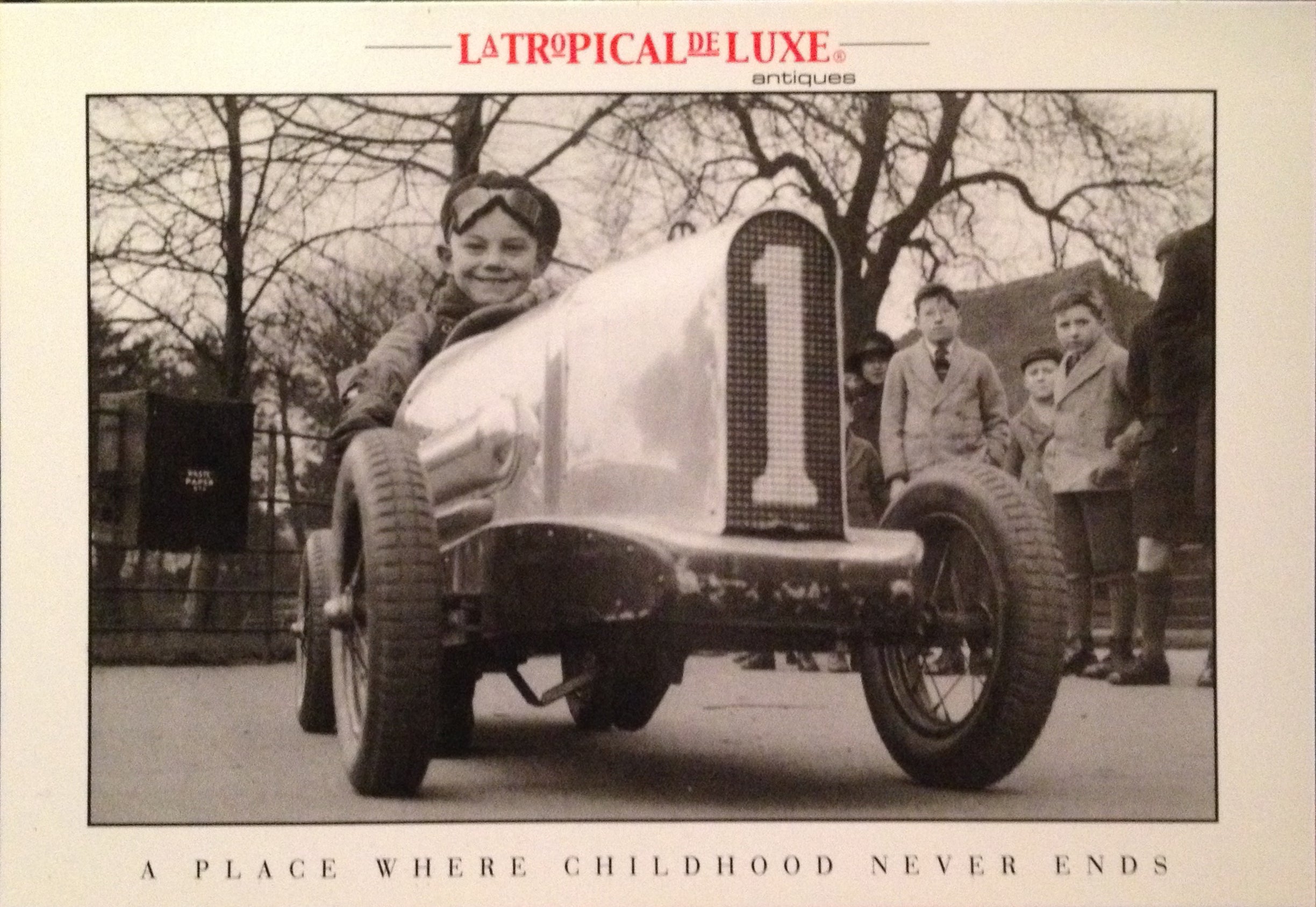
About the Seller
4.9
Vetted Professional Seller
Every seller passes strict standards for authenticity and reliability
Established in 2002
1stDibs seller since 2016
320 sales on 1stDibs
Typical response time: 1 hour
- ShippingRetrieving quote...Shipping from: Buenos Aires, Argentina
- Return Policy
Authenticity Guarantee
In the unlikely event there’s an issue with an item’s authenticity, contact us within 1 year for a full refund. DetailsMoney-Back Guarantee
If your item is not as described, is damaged in transit, or does not arrive, contact us within 7 days for a full refund. Details24-Hour Cancellation
You have a 24-hour grace period in which to reconsider your purchase, with no questions asked.Vetted Professional Sellers
Our world-class sellers must adhere to strict standards for service and quality, maintaining the integrity of our listings.Price-Match Guarantee
If you find that a seller listed the same item for a lower price elsewhere, we’ll match it.Trusted Global Delivery
Our best-in-class carrier network provides specialized shipping options worldwide, including custom delivery.More From This Seller
View All"Running Dog" Packard Car Mascot, 1933. Automobilia
Located in Buenos Aires, Olivos
A "Running Dog" Packard Car Mascot / Hood Ornament , 1933, Automobilia
Detailed silhouette in silvered brass, 5 inches long, mounted over a lucite base. Si...
Category
Mid-20th Century American Art Deco Animal Sculptures
Materials
Brass
Art Deco Brass Airplane desk Model, U.K. 1930´s
Located in Buenos Aires, Olivos
Art Deco Brass Airplane desk Model, 1930´s.
Lovely Aviation Desk model, made in United Kingdom 1930´s.
Excellent restored conditions. The airplane can be...
Category
Mid-20th Century British Art Deco Aviation Objects
Materials
Brass
Bugatti Tank Car Mascot / Hood Ornament / Paperweight. France 1930
Located in Buenos Aires, Olivos
Bugatti Tank Car Mascot / Hood Ornament / Paperweight. France 1930.
Silvered Bronze Sculpture depicting a Bugatti Type 32 ¨Tank¨ Car.
Mounted over an acylic base. Signed CAD.
Lovely ...
Category
Mid-20th Century French Art Deco Paperweights
Materials
Bronze
Sailboat Model, Painted Wooden Body, 1930s
Located in Buenos Aires, Olivos
Sailboat model on stand. Painted wood body and bronze accessories.
Made between 1920s-1930s. Very nice restored conditions.
Very decorative item, perfec...
Category
20th Century Unknown Art Deco Nautical Objects
Materials
Bronze
Art Deco / Mid-Century Hagenauer Two Racing Horses Sculpture. Austria
By Werkstätte Hagenauer Wien
Located in Buenos Aires, Olivos
Art Deco / Mid-Century Hagenauer Two Racing Horses Sculpture. Austria.
Stunning sculpture.
This is a wood and brass double horses sculpture circa 1930’s by Hagenauer . It is signed ...
Category
Mid-20th Century Austrian Mid-Century Modern Animal Sculptures
Materials
Bronze
Mid-Century Desk Model Airplane, USA, 1940's
Located in Buenos Aires, Olivos
Mid-century desk model airplane - USA 1940´s
Single engine fighter.
Cast aluminium perior aviation model, mounted over a marble base.
Excellent conditions.
We have specialized in t...
Category
Mid-20th Century American Mid-Century Modern Aviation Objects
Materials
Aluminum
You May Also Like
1930s Art Deco Race Car Metal Model, Highly Detailed, Collectible Decorative
Located in Milano, IT
Decorative Model Car - Art Deco Race Car - Man Cave Collectible
A highly detailed, extremely attractive model of a classic racecar, replica of the miniature-engine scale models used for "arena racing" in the 1930s, and especially at the New York World Fair of 1939.
Crafted with a metal body and wooden chassis, the not-so-little car is an ideal decorative piece for any car enthusiast, and can find its spotlight on a coffee table, bookshelf, or in your special mancave.
It has spoke wheels, functional steering and an opening bonnet that shows a faithful reproduction of the original engines fitted in yesteryears' racing models...
Category
2010s Dutch Art Deco Models and Miniatures
Materials
Stainless Steel
$1,389 Sale Price
7% Off
Antique Brass Toy Car Paperweight or Decorative Object, Early 20th Century
Located in Oklahoma City, OK
This antique brass toy car is a rare and charming relic from the early 20th century, meticulously cast in solid brass with fine attention to vintage automotive detail. From its spoke...
Category
Early 20th Century American Industrial Toys and Dolls
Materials
Brass
Betel Motor Brass Model Car, Art Deco Box, Collectible Paint Set, 1930s
Located in Roma, IT
Lovely Art Deco model car fully made in brass. This charming model car box with many purposes was made in the US during the 1930s.
Patent 75086 - This elegant and rare brass model c...
Category
Early 20th Century American Art Deco Models and Miniatures
Materials
Metal, Brass
Antique 1913 Model Touring Car and Driver Wooden Hand Painted Sculpture
Located in Plainview, NY
A meticulously crafted 1913 model touring automobile. The car model features a two-tone color scheme, predominantly black with red accents, which highlights its vintage allure. The...
Category
20th Century American Art Deco Models and Miniatures
Materials
Wood
Collectible Toy Car, Antique Meccano Brass Display Toy Car
Located in Miami, FL
Collectible Toy Car, Antique Meccano Brass Display Toy Car
Meccano toy car, this impressive system of construction, born at the beginning of the 20th century makes a great collectible toy.
Toy store...
Category
20th Century English Toys and Dolls
Materials
Metal
$355 Sale Price
25% Off
1930s Racing Car Black and Red Scale Model, Highly Detailed, Medium Size
Located in Milano, IT
Stunning contemporary reproduction of a vintage racing car from the 1930s. The streamlined body, exhaust pipes, wheels and dashboard are all faithfully reproduced and highly detailed...
Category
2010s European Art Deco Models and Miniatures
Materials
Metal, Steel, Stainless Steel, Chrome
$709 Sale Price
20% Off
More Ways To Browse
House Model
Wood Architecture Model
French Ship Model
Architectural Model House
Wood Car
Wood Ship Model
Antique Miniature Painting
Antique Silver Miniatures
Early American New England Furniture
Cased Model Ship
1970 S Early American Furniture
Antique Miniature Silver Furniture
Antique Ship Models
Antique Miniature Houses
Danish Model Ships
1960 Vintage Early American Furniture
Antique French Miniature
Bar Car
